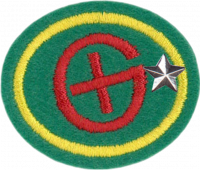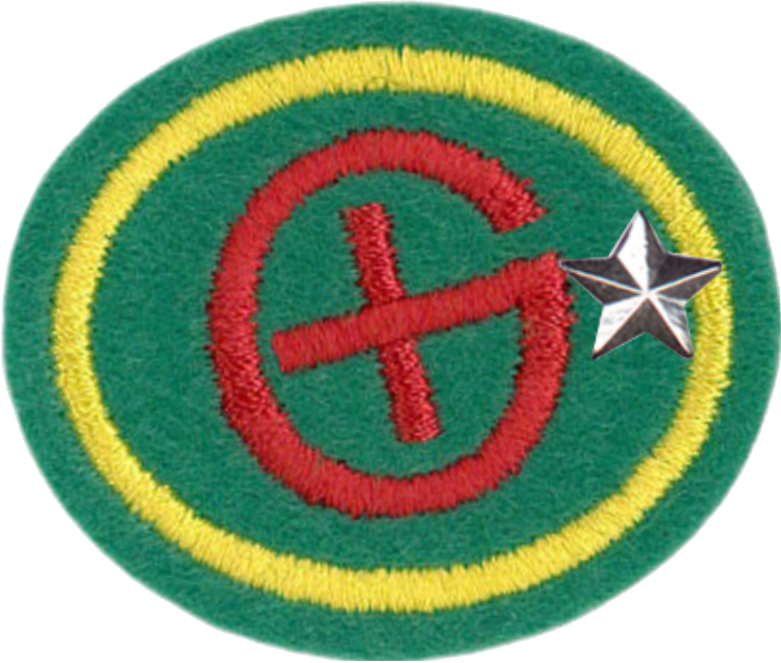AY Honor Geocaching - Advanced Answer Key used by General Conference
Skill Level
2
Year
2005
Version
10.01.2026
Approval authority
North American Division
1
For tips and instruction see Geocaching.
2
History
The design of GPS is based partly on the similar ground-based radio navigation systems, such as LORAN and the Decca Navigator developed in the early 1940s, and used during World War II. Additional inspiration for the GPS system came when the Soviet Union launched the first Sputnik in 1957. A team of U.S. scientists led by Dr. Richard B. Kershner were monitoring Sputnik's radio transmissions. They discovered that, because of the Doppler effect, the frequency of the signal being transmitted by Sputnik was higher as the satellite approached, and lower as it continued away from them. They realized that since they knew their exact location on the globe, they could pinpoint where the satellite was along its orbit by measuring the Doppler distortion.
The first satellite navigation system, Transit, used by the United States Navy, was first successfully tested in 1960. Using a constellation of five satellites, it could provide a navigational fix approximately once per hour. In 1967, the U.S. Navy developed the Timation satellite which proved the ability to place accurate clocks in space, a technology the GPS system relies upon. In the 1970s, the ground-based Omega Navigation System, based on signal phase comparison, became the first world-wide radio navigation system.
The first experimental Block-I GPS satellite was launched in February 1978. The GPS satellites were initially manufactured by Rockwell International and are now manufactured by Lockheed Martin.
Timeline
- In 1972, the US Air Force Central Inertial Guidance Test Facility (Holloman AFB) conducted developmental fight tests of two prototype GPS receivers over White Sands Missile Range, using ground-based pseudo-satellites.
- In 1978 the first experimental Block-I GPS satellite was launched.
- In 1983, after Soviet interceptor aircraft shot down the civilian airliner Korean Air Flight 007 in restricted Soviet airspace, killing all 269 people on board, U.S. President Ronald Reagan announced that the GPS system would be made available for civilian uses once it was completed.
- By 1985, ten more experimental Block-I satellites had been launched to validate the concept.
- On February 14, 1989, the first modern Block-II satellite was launched.
- In 1992, the 2nd Space Wing, which originally managed the system, was de-activated and replaced by the 50th Space Wing.
- By December 1993 the GPS system achieved initial operational capability.
- By January 17, 1994 a complete constellation of 24 satellites was in orbit.
- Full Operational Capability was declared by NAVSTAR in April 1995.
- In 1996, recognizing the importance of GPS to civilian users as well as military users, U.S. President Bill Clinton issued a policy directive declaring GPS to be a dual-use system and establishing an Interagency GPS Executive Board to manage it as a national asset.
- In 1998, U.S. Vice President Al Gore announced plans to upgrade GPS with two new civilian signals for enhanced user accuracy and reliability, particularly with respect to aviation safety.
- On May 2, 2000 "Selective Availability" was discontinued as a result of the 1996 executive order, allowing users to receive a non-degraded signal globally.
- In 2004, the United States Government signed a historic agreement with the European Community establishing cooperation related to GPS and Europe's planned Galileo system.
- In 2004, U.S. President George W. Bush updated the national policy, replacing the executive board with the National Space-Based Positioning, Navigation, and Timing Executive Committee.
- November 2004, QUALCOMM announced successful tests of Assisted-GPS system for mobile phones.
- In 2005, the first modernized GPS satellite was launched and began transmitting a second civilian signal (L2C) for enhanced user performance.
3
- Latitude
- Latitude describes the north-south position on the globe and is measured in degrees, minutes, and seconds. The 0° line is a circle around the Earth's equator. Latitude changes as one moves north to south, or south to north. It does not change as one moves from east to west or west to east.
- Longitude
- Longitude describes the east-west position on the globe, and like latitude, is also measured in degrees, minutes, and seconds. All longitude lines begin and end at the North and South Poles. The 0° longitude line begins at the North Pole, passes through Greenwich, England, and then continues to the South Pole. Longitude changes as one moves east to west, or west to east. It does not change as one moves from north to south or south to west.
- Degrees
- Most people become familiar with the angular measurement of a degree in a mathematics class when they are introduced to the protractor. The degree used in Geocaching is this very same measurement. Latitude measures the angle made by two lines which both originate at the very center of the Earth. The first line extends from the center of the Earth to the equator, and the second line extends from the center of the Earth to the position being described. Longitude is similar, measuring the angle formed by two lines - one extending from the center of the Earth to the equator directly south of Greenwich, England, and the other extending from the center of the Earth to a position on the equator directly north or south of the measured position.
- Minutes
- A degree is not a very precise measurement of an angle when considering something as large as the planet Earth. If only degrees were used to specify a person's position, we could only get within about 100km
 of the person's position. Therefore, a degree is divided into 60 finer measurements called minutes. Minutes in Geocaching has little to do with time.
of the person's position. Therefore, a degree is divided into 60 finer measurements called minutes. Minutes in Geocaching has little to do with time. - Seconds
- Even with the finer angular resolution of minutes, we can still only get to within about 1670 meters
 of a person's position, so the minute is divided into seconds. One second can get us to within about 28 meters
of a person's position, so the minute is divided into seconds. One second can get us to within about 28 meters of a position, so they are typically specified to a couple of decimal places, as in "25.65 seconds".
of a position, so they are typically specified to a couple of decimal places, as in "25.65 seconds".
Latitude and longitude are specified in degrees, minutes, and seconds, as in 43°22'54.31". Here the number preceding the ° symbol (43) is the number of degrees, the number preceding the ' (22) is the number of minutes, and the number before the " (54.31) is the number of seconds. When we go down to one hundredth of a second, we can specify a location to within about 28 cm![]() .
.
4
4a
Be sure to read these guidelines for hiding a geocache. In short:
- Choose an area to hide your geocache
- Make sure it's legal, and that you have permission.
- Make sure that the added attention of geocachers will not damage a sensitive site (historic or natural)
- Hide it out of sight of casual passersby.
- Prepare your cache
- Choose a container. Popular choices include plastic food-storing containers such as Tupperware, ammo boxes, and water-proof boxes used on boats. The container should be waterproof and be able to withstand the rigors of the weather.
- Add a logbook and (optionally), a pencil. Ink freezes.
- Write a note to the geocachers who find your cache.
- Add a small gift (optional)
- Add a Travel Bug (optional)
- Get the GPS coordinates
- Make sure they are accurate.
- Take several readings and average them
- Follow your GPS to the site from different directions
- Write the coordinates on the container and in the logbook.
- Register your cache
- Find the form at http://geocaching.com
- Write up a good description of the area, including notes of interest (history, etc.)
- Double-check for accuracy
- Maintenance
- Check that the container is still water-tight and seals properly
- Check that the logbook is still there
- Assess the area for damage caused by cachers and make adjustments if necessary
4b
You can order travel bugs from geocaching.com and from other places as well. Think of some sort of goal for your TB, and plant it in a cache - maybe even one you have started yourself in requirement 6a above.
4c
Though travel bugs are not expensive, it's even cheaper to find them and track them than it is to buy one and send it out. Watch the geocaches in your area and look for TB's to be dropped off in them. Then pick them up and help them meet their goals.
4d
Check the geocaching calendar to find an event near you. If there is not one, you could always host one yourself. If you host it at your church you will raise your community's awareness of your church. However, do not try to make this an evangelistic meeting, as this would be frowned upon by the geocaching community and would give you and your church a bad name. It is enough that people learn where your church is.
5
5a
The U.S. National Park Service prohibits geocaches on land it manages.
5b
It is a federal offense in the United States to trespass on an active railroad right-of-way. Geocaches should be located a minimum of 45 meters![]() from any active rail line.
from any active rail line.
5c
A person who places a cache is responsible for maintaining it. This means it must be physically visited on a regular basis. Unless the cache placer is able to pay frequent visits to the cache site, the cache should not be placed.
5d
National Forests are managed by the U.S. Forest Service, which recognizes geocaching as a legitimate recreational activity. However, geocachers must be careful to observe the rules of using the National Forests. Trees, plants, and streams are not to be damaged.
Wilderness areas within National Forests are not to be used for geocaching. These areas are to remain undeveloped, and all traces of human activity are to be minimized.
5e
6
- a. Traditional cache with 3-star difficulty
- b. One Multi-level
- c. One virtual
- d. One micro
You can record your finds on the geocaching website, so don't worry about setting up some sort of elaborate system. Getting each of these types of cache will most likely come naturally, so you don't really need to pay particular attention to that when you get started. As you near your 18th cache, check them over and see how many of these four types you already got "automatically" - then work on getting the rest. By the time you log your 18th, you will likely have found a new hobby, and more will come.
Virtual caches were discontinued and only a few remain grandfathered. Earthcaches, however, are a form of virtual cache.
Requirement b) says Multi-level but should really be Multi-stage or just Multi-cache which is what Geocaching.com calls them.
7
From the Main Page of www.geocaching.com at the top right, click on “Create a Membership!”, for a free account choose “Get a Basic Membership”. This is a family friendly, kid safe web site. No personal information is available from this site. Emails are safe and password protected through this system. When you are a member you can post into the logbooks your cache finds.
Note to instructors: Notice that these requirements do leave the opportunity for a GROUP to go find a cache and use a pre-existing Geocaching account to write the log on the geocache website. Each individual Pathfinder does NOT need to write a log. No "register for a free Geocaching.com account" requirement until the Advanced honor.


